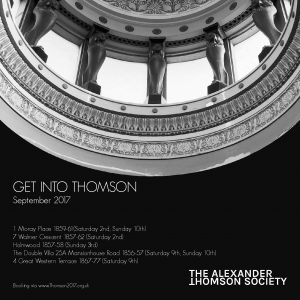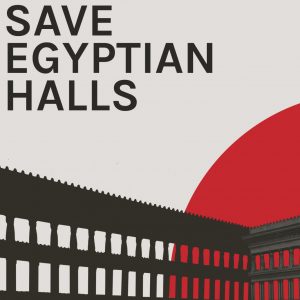To celebrate the bicentenary of Alexander ‘Greek’ Thomson‘s birth a programme of events and activities have been planned to take place throughout 2017. We will continue to update this calendar throughout the year with more and more exciting events as these are confirmed so please keep checking back. You can also sign up to our e-mail newsletter here to stay up to date.

Booking opens to the public 6pm 28 August 2017
The Alexander Thomson Society have organised a series of special Thomson residential openings during the first two weekends in September 2017, as part of the ongoing events celebrating Alexander Thomson’s Bicentenary. This has been made possible due the generosity of the owners of the houses involved as listed below.
1 Moray Place 1859-61 (Saturday 2nd, Sunday 10th) Alexander Thomson’s former home, the first house in an exceptional terrace with a revealed painted decorative scheme.
7 Walmer Crescent 1857-62 (Saturday 2nd) Thomson’s fine crescent composed of straight elements with minimal decorative elements, built for John Hood.
Holmwood 1857-58 (Sunday 3rd) Thomson’s fine villa for James Couper of Cathcart now owned by the National Trust for Scotland, with newly reinstated painted decorative scheme in the Dining Room and Hall.
The Double Villa 25A Mansionhouse Road 1856-57 (Saturday 9th, Sunday 10th) Southern half of the ingeniously designed pair of semi detached houses that form the Double Villa or Maria Villa, built for Henry Watson.
4 Great Western Terrace 1867-77 (Saturday 9th) Thomson’s grandest terrace for William Henderson and James Whitelaw Anderson, composed of eleven terraced townhouses, completed after Thomson’s death by JJ Burnet.
Please note only booked visitors will be allowed into the houses and we would request that people arrive promptly to allow the visits to begin at the times indicated (12pm, 1pm, 2pm and 3pm for each property). Each visit will last slightly less than 1 hour.
If you book and are unable to attend it would be very helpful to let Eventbrite know this, to allow your place to be booked by someone else, as the numbers are restricted. Should you wish any further information please contact the Society at info@alexanderthomsonsociety.
Booking for all properties opens at 11am Sunday 27 August 2017, tickets will then become available to the general public from 6pm Monday 28 August 2017.

Booking opens to the public 6pm 28 August 2017
The Alexander Thomson Society have organised a series of special Thomson residential openings during the first two weekends in September 2017, as part of the ongoing events celebrating Alexander Thomson’s Bicentenary. This has been made possible due the generosity of the owners of the houses involved as listed below.
1 Moray Place 1859-61 (Saturday 2nd, Sunday 10th) Alexander Thomson’s former home, the first house in an exceptional terrace with a revealed painted decorative scheme.
7 Walmer Crescent 1857-62 (Saturday 2nd) Thomson’s fine crescent composed of straight elements with minimal decorative elements, built for John Hood.
Holmwood 1857-58 (Sunday 3rd) Thomson’s fine villa for James Couper of Cathcart now owned by the National Trust for Scotland, with newly reinstated painted decorative scheme in the Dining Room and Hall.
The Double Villa 25A Mansionhouse Road 1856-57 (Saturday 9th, Sunday 10th) Southern half of the ingeniously designed pair of semi detached houses that form the Double Villa or Maria Villa, built for Henry Watson.
4 Great Western Terrace 1867-77 (Saturday 9th) Thomson’s grandest terrace for William Henderson and James Whitelaw Anderson, composed of eleven terraced townhouses, completed after Thomson’s death by JJ Burnet.
Please note only booked visitors will be allowed into the houses and we would request that people arrive promptly to allow the visits to begin at the times indicated (12pm, 1pm, 2pm and 3pm for each property). Each visit will last slightly less than 1 hour.
If you book and are unable to attend it would be very helpful to let Eventbrite know this, to allow your place to be booked by someone else, as the numbers are restricted. Should you wish any further information please contact the Society at info@alexanderthomsonsociety.
Booking for all properties opens at 11am Sunday 27 August 2017, tickets will then become available to the general public from 6pm Monday 28 August 2017.

The Save Egyptian Halls symposium brings speakers together discuss the significance of this A-listed building and how it might be saved.
Timetable tbc, speakers include:
Niall Murphy – Glasgow City Heritage Trust
Fiona Sinclair – Fiona Sinclair Architects
Scott Abercrombie / Mark Baines – The Alexander Thomson Society
Ben Adam – David Narro Associates
Andrew McConnell – Glasgow Building Preservation Trust
Dara Parsons – Historic Environment Scotland
Jamie McNamara – Society for the Protection of Ancient Buildings

We are delighted that this year’s Alexander Thomson Lecture will be delivered by Amin Taha. The London-based, Stirling Prize nominated architect of buildings such as 15 Clerkenwell Close and Barrett’s Grove will deliver a talk reflecting on his work and his approach to architecture.
The Society were interested by Amin’s approach to the use of stone masonry, texture and pattern, and his abstracted use of classical forms in his Upper Street project.

